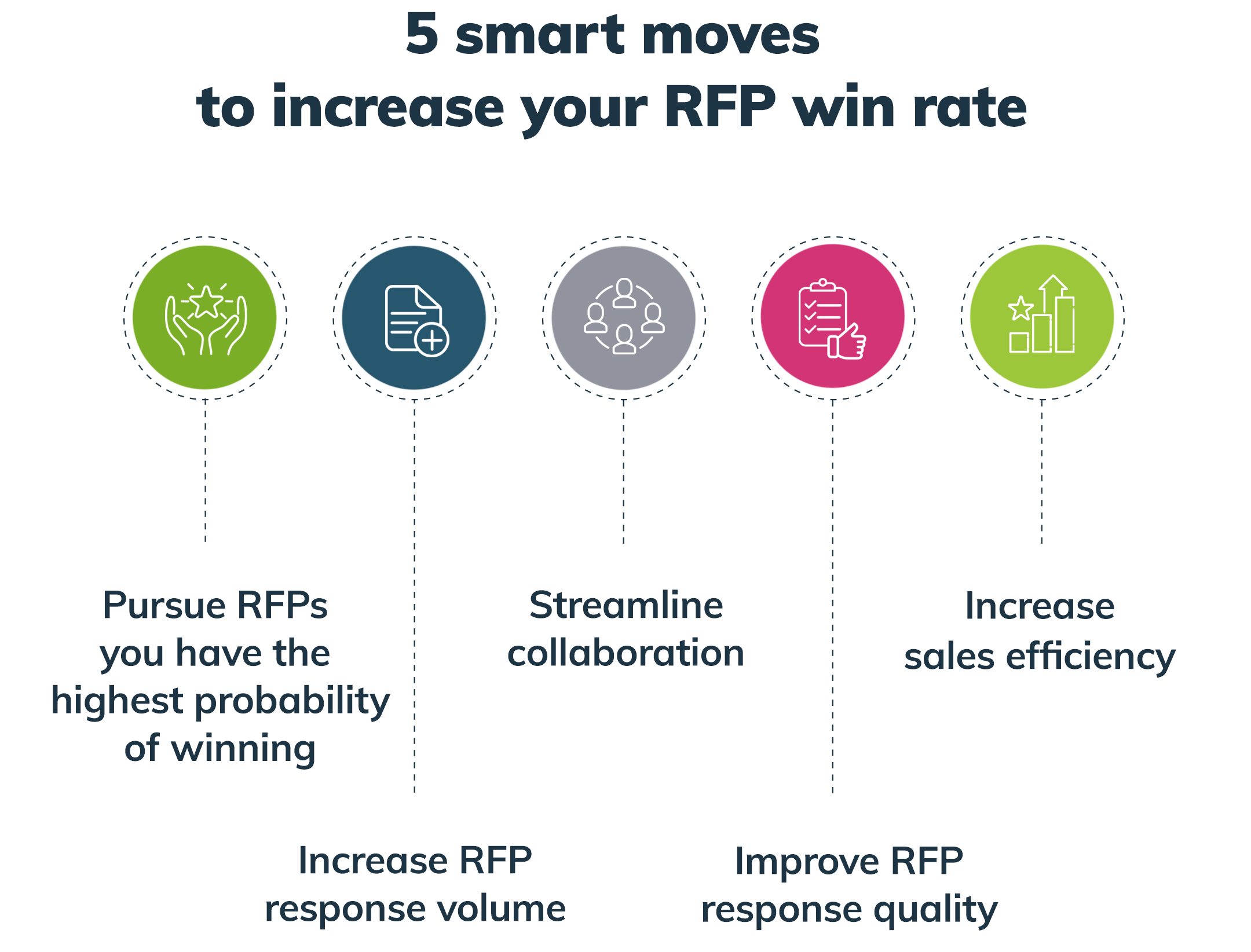There are two primary reasons why you should aggressively pursue requests for proposals (RFPs). One, they’re a great way to build pipeline. Which is key for the 69% of B2B salespeople who do not have enough leads in their pipeline to meet quota. Two, they can be a major revenue driver. You just have to make sure you’re pursuing the right RFPs and doing so as efficiently as possible. Take my word for it. Just kidding. I actually have data to back it up. I also did an entire webinar on this topic, if you’re ready for a deep dive.
RFPs: Opportunity and Risk
Globally, $11 trillion of revenue is won through competitive proposal processes (RFPs) every year. You may be asking, “What is a good proposal win rate?” Responsive’s research puts the average RFP win rate at 45%. But that’s across all industries. It will vary according to your level of specialization. RFPs exist in multiple markets, including government, construction, supply chain, manufacturing, systems integration, healthcare, and technology.
$11 trillion of revenue is won through competitive proposal processes (RFPs) every year.
As a salesperson, I always wanted to include RFPs to help grow my pipeline. A healthy sales pipeline is 4-5x the close rate, and RFPs can represent deal sizes large enough to keep my pipeline super healthy. Since working in sales, I’ve led proposal teams and now have my own company, Patri, that helps qualify sales opportunities, including RFPs. I’ve also learned that too many salespeople and leaders are avoiding RFPs.
RFPs are not easy, and they can be labor-intensive. I’ve known many salespeople who find them too restrictive. In other words, there’s too much red tape to navigate to put together a response.
The fact is that only a little over half of all salespeople are hitting their quotas. There’s a lot of desperation out there. If you’re already in desperation mode, then the notion of allocating resources to an RFP proposal is tantamount to putting all your eggs in one basket. Proposal opportunities are more than 5x more expensive than traditional sales opportunities. As a result, companies are spending an estimated $200+ billion per year on lost bid opportunities alone.
Companies are spending an estimated $200+ billion per year on lost bid opportunities alone.
So if you boil it all down, objections to pursuing RFPs come down to time and finding the right opportunities. I’m going to unleash my inner salesperson and help you overcome those objections. Let’s look at the data.

5 smart moves to increase your RFP win rate
- Pursue RFPs you have the highest probability of winning: Qualifying RFP opportunities before you respond helps reduce your loss rate and increase your win rate. Patri clients have saved $26 million and 27,000 hours by focusing efforts only on opportunities they can realistically win.
- Increase RFP response volume: Teams with dedicated proposal professionals submitted 3.5x more responses in 2020.
- Increase sales efficiency: Teams using RFP software submit an average of 46% more responses every year.
- Improve RFP response quality: Medical device manufacturer IBA re-invested time saved from RFP software into improving response quality and increased win rate by 15% in the first year.
- Streamline collaboration: 38% of responders cite collaborating with subject matter experts (SMEs) to create and review content as their biggest headache.
So that gives you an idea of what you can do. Now, how can you win more RFPs? Qualify opportunities and implement RFP response software.
How to win more RFPs in 3 steps
Step 1: Qualify based on data
I remember early in my proposal response days, I was the salesperson and proposal manager. Wearing both hats, anything I wanted to pursue I had to make sure was winnable. Some of those early parameters were relationship status, incumbency, solution fit, and requirement fit. I grew this exercise in qualification into my company, Patri.
Patri sits between RFP identification and response, at that pivotal qualification point. We analyze data to provide clients a fit score and call out their strengths and weaknesses that will play into their pursuit of an opportunity. So far, we have helped qualify more than $40 billion of opportunities and helped win $84.6 million worth of business.
Step 2: Save and re-invest time
When clients agree that an opportunity is fit enough to pursue, we recommend that they use RFP software to craft the best response possible. Solutions such as Responsive automate manual processes and improve collaboration, freeing up your time for other things. The more time you have to fine-tune your proposal, the better your proposal will be, and the higher your win rate.
RFP software helps proposal and sales teams save time (and achieve higher win rates) by:
- Cutting response time by an average of 40%: Automatically respond to commonly-seen questions with Auto Respond, automation functionality powered by machine learning.
- Managing and moderating content and projects: Organize RFP content, import projects, assign tasks, respond to questions, set up review cycles, and export into the source file or custom template.
- Streamlining cross-functional collaboration: Easily collaborate across teams using in-app @mentioning and integration with Slack, Microsoft Teams, Google Hangouts, and Jira.
- Making data-driven decisions: Gain insight into time spent, deals won, and resources used with built-in business intelligence and analytics.
- Integrating into your existing tech stack: Responsive integrates with more platforms than anyone, including popular CRM, SSO, cloud storage, and communication platforms.
The primary indicator for RFP software, like any other automation software, is that it saves time. It’s what you do with that time that will determine your level of success with increasing RFP win rate.
Re-invest time into responding to more RFPs with higher quality proposals. Also, like a pure shooter who moves well off the ball (a la Craig Hodges for 90s-era Bulls fans or Klay Thompson for current Warriors fans), you can work on your process outside of active projects. In other words, re-invest time into improving your content. So when that next RFP comes in you not only have content that’s locked and loaded, it’s high quality, too, which will improve your odds of getting shortlisted.
Step 3: Designate an owner of the response process
While RFP software delivers efficiency, you will get more value out of it if you have a dedicated proposal manager administering the software and the processes around it. This de-facto leader of the proposal team will also be responsible for:
- Building relationships with other company stakeholders, including sales, product, legal, and marketing teams.
- Driving user adoption, knowledge management, and other essential functions associated with RFP software.
- Enabling sales to have a streamlined, unfettered user experience to minimize objections and elevate the value of RFPs in pipeline management.
Finally, it’s important to note that you don’t have to make double-digit gains in your RFP win rate to realize impressive results. For example, if a company’s average RFP is worth $570,000 and they submit 415 RFPs annually, with a win rate of 32%, the business value of their RFP process is $75,696,000. Improving the win rate just 2% would represent a nearly $5 million dollar increase.

Pursuing RFPs doesn’t have to be a black box experience. Be transparent within the company. Know your costs and win rate probability. Go and embrace them. By properly qualifying opportunities and using RFP software, you can improve your own odds.
To learn more about how Patri can help you qualify opportunities, schedule a demo. To see if your RFP management process is ready for automation by Responsive, schedule a demo.
